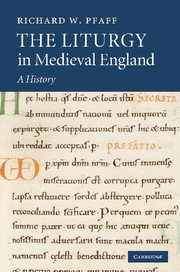Book contents
- Frontmatter
- Contents
- Preface
- Sigla and editorial conventions
- Bibliographical abbreviations
- Nicknames for manuscripts frequently referred to
- 1 Introduction
- Excursus: on sources
- 2 Early Anglo-Saxon England: a partly traceable story
- Excursus: on the terms Gregorian and Gelasian as used here
- 3 Later Anglo-Saxon: liturgy for England
- 4 The Norman Conquest: cross fertilizations
- Excursus: on method in the comparison of liturgical texts
- 5 Monastic liturgy, 1100–1215
- Excursus: on ascription of liturgical books to specific churches
- 6 Benedictine liturgy after 1215
- 7 Other monastic orders
- 8 The non-monastic religious orders: canons regular
- 9 The non-monastic religious orders: friars
- Excursus: on liturgical books from female religious houses
- 10 Old Sarum: the beginnings of Sarum Use
- 11 New Sarum and the spread of Sarum Use
- 12 Exeter: the fullness of secular liturgy
- 13 Southern England: final Sarum Use
- 14 Regional Uses and local variety
- 15 Towards the end of the story
- Index of Manuscripts
- Index of Saints
- General Index
Excursus: on liturgical books from female religious houses
Published online by Cambridge University Press: 20 March 2010
- Frontmatter
- Contents
- Preface
- Sigla and editorial conventions
- Bibliographical abbreviations
- Nicknames for manuscripts frequently referred to
- 1 Introduction
- Excursus: on sources
- 2 Early Anglo-Saxon England: a partly traceable story
- Excursus: on the terms Gregorian and Gelasian as used here
- 3 Later Anglo-Saxon: liturgy for England
- 4 The Norman Conquest: cross fertilizations
- Excursus: on method in the comparison of liturgical texts
- 5 Monastic liturgy, 1100–1215
- Excursus: on ascription of liturgical books to specific churches
- 6 Benedictine liturgy after 1215
- 7 Other monastic orders
- 8 The non-monastic religious orders: canons regular
- 9 The non-monastic religious orders: friars
- Excursus: on liturgical books from female religious houses
- 10 Old Sarum: the beginnings of Sarum Use
- 11 New Sarum and the spread of Sarum Use
- 12 Exeter: the fullness of secular liturgy
- 13 Southern England: final Sarum Use
- 14 Regional Uses and local variety
- 15 Towards the end of the story
- Index of Manuscripts
- Index of Saints
- General Index
Summary
Had the extant sources permitted this, it would have been desirable to call this Excursus simply, “On liturgy in female religious houses.” As things stand, we can only indicate a couple of considerations that apply generally, then provide a brief list of what does survive, and finally look at the one house, Barking, for which several sources are available. Because the sections on the Gilbertines (pp. 303–10) and Bridgettines (pp. 529–39) deal primarily with the female members of those “mixed” religious orders, information given there will not be repeated here.
The most obvious generalization is that those books which survive and can be attributable to a specific female house are overwhelmingly psalters (and Horae, excluded from the present work). This is a point that may have a wider application than is immediately obvious. It may say something about the priorities for expenditure in nunneries (the term, if not exactly accurate in all cases, will be used here as an alternative to the bulky “female religious houses” or “houses for women”) that it does not seem possible to ascribe a single extant massbook to them. Does this fact suggest that the male celebrants generally brought their own missals – which is scarcely to be supposed – or even that it was not thought appropriate for nunneries to own missals – which is absurd? But it remains the case that, of some thirty manuscript books (or substantial fragments) that can with some confidence be ascribed to English nunneries, not one is a missal.
- Type
- Chapter
- Information
- The Liturgy in Medieval EnglandA History, pp. 342 - 349Publisher: Cambridge University PressPrint publication year: 2009



